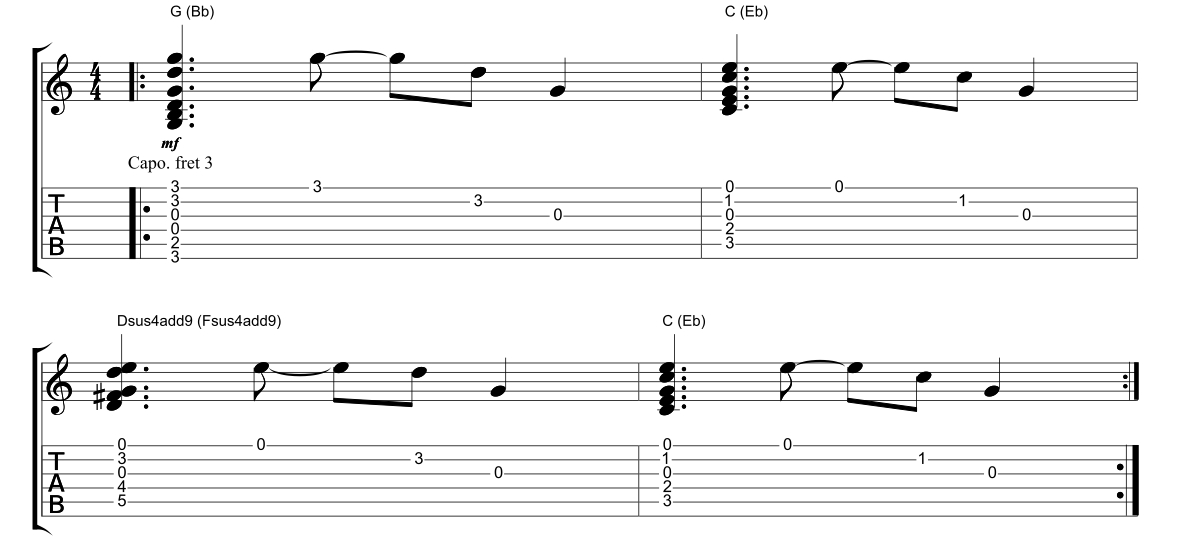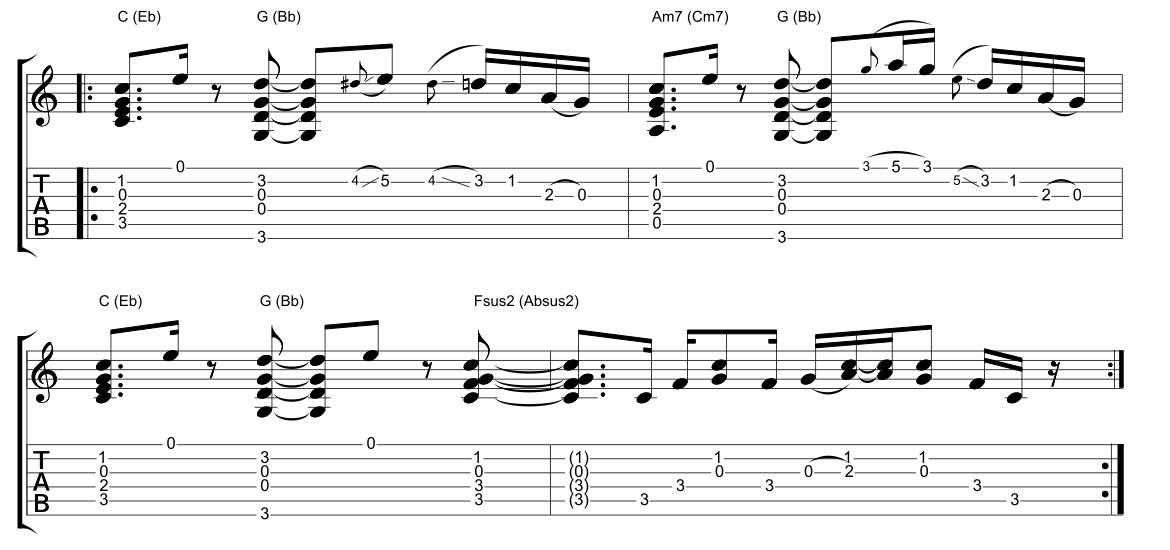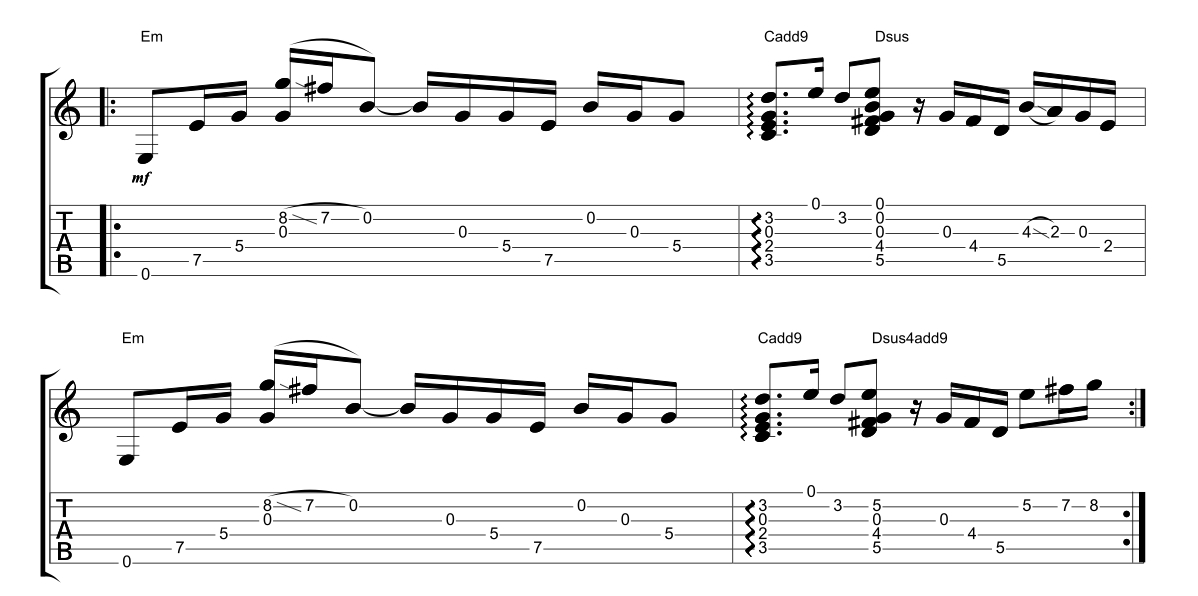Pop/Rock Acoustic Capo Chords on Guitar
In today’s lesson we explore how using a capo can bring life to open chords and allow you to play in any key. All of todays examples are played on an acoustic with the capo placed at the 3rd fret, however feel free to experiment with using an electric and moving the capo around the fretboard.
Buying a capo
Before we look at the examples I want to make the point that cheap capos £5/$8 are a waste of money. They usually will not fit well and often can make notes clunky. I personally recommend and have always used Kyser capos, but most capos above £15/$24 should be sufficient. Remember the old adage “buy cheap, buy twice” when buying gear.
Why use a capo?
The main reason for using a capo is that you can move open ringing chords into different keys. This works particularly well on an acoustic and when backing a vocalist especially in duet form. Open chords provide a quality that can’t be replaced with barre chords and today’s examples provide a glimpse into what can be achieved by adding a capo to your playing. Although these examples are recorded on an acoustic they work well on an electric as well. Pop bands such as Razorlight brought capo playing to the mainstream with tracks such as America.
Example 1 – Pop Capo Chords
Example one revolves around the three simple open chord shapes of ‘G’ ‘C’ and ‘C’ up two frets from its original position. The ‘C’ up two frets or ‘Dsus4add9’ shape commonly replaces an open D chord and provides a lovely ringing sound. Remember that we name the chords as if they were standard open chords however the chord you have actually created is in a new key. For all of the examples seen in today’s lesson the actual chord created will be shown in brackets.

Example 2 – Fingerpicked Chords
Fingerpicking and using a capo work beautifully together. This example uses the shapes of C, G, Am7 and Fsus2 and fills the gaps with some lovely country/blues fills. Make sure you watch the slowed down version of this example to see how I approach fingerpicking this idea.

Example 3 – It’s Not Over Introduction
The third example is the introduction to a piece I wrote a few months back called It’s Not Over. The only difference being that the original uses the capo at the 4th fret and not the 3rd. This piece expands on the idea of ringing open chords and uses some slides to add emotion.

Recommended listening
For beautiful acoustic rhythm playing licks, I recommend buying the album You’ve Got A Friend by James Taylor. My favourite track on that album being “Fire And Rain.”
Subscribe on Youtube
Make sure you log on and subscribe to our new YouTube Channel, dedicated to bringing you the finest free guitar lessons.
Guitar Lesson Video Transcription
Hi YouTube, Simon here once again for Fundamental Changes. Today we’re carrying on with our pop rock acoustic, and we’re looking at one of my favorite devices, and that’s using a capo. Let’s go and have a look at 3 examples, just after this.
Hi everyone, I’m very excited to announce my first book, it’s being released on the Fundamental Changes label. It’s Exotic Pentatonic Soloing for Guitar. It’s got 11 pentatonic scales, including 90 minutes of video so you can watch everything that I’ve written in this book. You get the passwords for it when you buy the book. 6 backing tracks, 55 licks, a wide variety of styles, scale shapes, tips and tricks as well. The link to this is below this video. I hope you check it out, I think you’ll really enjoy it.
[guitar playing]
Before we start these examples today fully, I just wanted to say don’t buy a really cheap capo. If you’re spending about 8 dollars or 5 pounds on one that just wraps around, it’s going to sound rubbish. It’s not a good starting point. I recommend spending 15 pounds or 25 dollars as a starting point. Anything from there up should be good. I personally play Kayser capos – I’ve always used these, I’ve had 3 and they’ve lasted me about 8 years. You’re never, never going to need another one, they sound brilliant. Anyway, Example 1 today uses a G chord (big open G), a C, a C up 2 frets ,which creates a Dsus chord (don’t worry too much about the naming of that today), and back. A very common sequence in pop acoustic-type styles is instead of just playing the normal D shape using your C, up 2 frets to create this really ring-y sus type chord. Sounds wonderful, still a little picking pattern there. Now, all your open chords, you can work on just moving around the neck, and of course you’re moving this into different keys.
So, even though we’re naming it G, C, and D, you always name it the shape, you’re actually in a new key here. You’re getting B flat, E flat, and a type of F there as well. So just be aware of that, even though the name’s G, C, and D, you are now in a new key because you’ve essentially just moved the nut to the 3rd fret, so obviously I can’t play below a 3rd fret. All the examples today are going to be using a capo at the 3rd fret. Let’s have a look at Example 2.
[guitar playing]
There was Example 2 around the key of E flat major, or using the C shape with the capo at the 3rd fret. It’s basically around this E flat and B flat here mainly, and then you’re using a C minor 7 shape, and at the end you’ve got a type of little A flat using an F shape open chord there. This one, introducing some little slides, some really nice little almost blues-y country textures with the capo on there as well. Between these very commonly used open chords, I want you to become aware of what you can do just by popping a capo on and using open chords in a new place gives a ringing texture, especially good when you’re backing a vocalist or even better, when you’re just a duo acoustic and vocal as well. Capos work brilliantly on acoustics too, but today we’re mainly looking at acoustic ideas. Work on that one slowly, get used to the little slides, make sure you’re quite precise with these slides to get the middle intonation that you heard when I played that there. Let’s have a look at Example 3.
[guitar playing]
Example 3 was taken from a piece I wrote a little while back. The full link to that piece will be in the article, so have a look at that if you like this sound. The original had a capo at the 4th fret; I’ve just done all these in the 3rd fret today for keeping it the same. This time, we’ve got a G minor chord in a little bit of an unusual shape. We’ve got open – I’m going to name the frets as if the capo wasn’t on there, just for ease for you – open, 10, 8, nothing, 11, open. Now in the tab, obviously, that will say them in relation to their… So that’ll be 1-2-3-4-5-6-7-8th fret, and etc.Don’t worry about that too much. There’s our G minor chord, and then we’ve got our E flat using a C add9 shape, and then a little par of that C chord you just saw in Example 1. This is the 3 notes before the little melodic run there,really nice picking pattern going along with this as well, but you can make up your own. The idea is just getting used to slightly different shapes. Instead of having E minor, C, this C up 2 frets (which is basically what the chord sequence is), we’re stretching it out and using a different voicing.
My tips for you today are: Try out some interesting open chord voicings that you may have come across in the past, or even just normal chord voicings, and just move your capo and try and find what I call the sweet spot on your acoustic or electric – it’d be more pronounced on an acoustic. On this instrument, it’s the 3rd and the 4th fret on this, but you might find you really like it higher up the neck, so just experiment. Just take even a simple G, C, D, and play it in different keys, fingerpick, use a plectrum, hybrid pick – use a mixture of fingers and a plectrum, and see what new ideas you can come up with using a capo. That’s pop rock acoustic using a capo. Hope you’ve got something from it, leave any comments below. I’m so grateful for all of you people who’ve written to both myself and Joseph, we highly appreciate all your comments, and we’ll speak to you soon. Take care.
Hi everyone, hope you’ve got something from this lesson. Make sure you go over and check the Fundamental Changes link for this article below, and look at Joseph’s books on Amazon as well, and I will see you next time for way more free videos. Take care.
“The artists you work with, and the quality of your work speaks for itself.”
Tommy Emmanuel
© Copyright Fundamental Changes Ltd 2025
No.6 The Pound, Ampney Crucis, England, GL7 5SA
